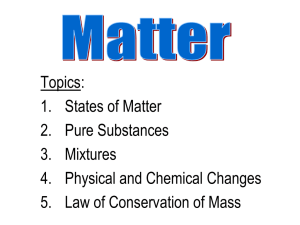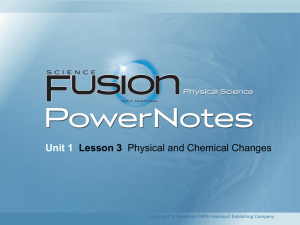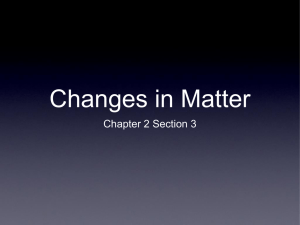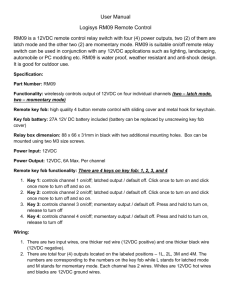18 Classical Indian Metaphysics
advertisement
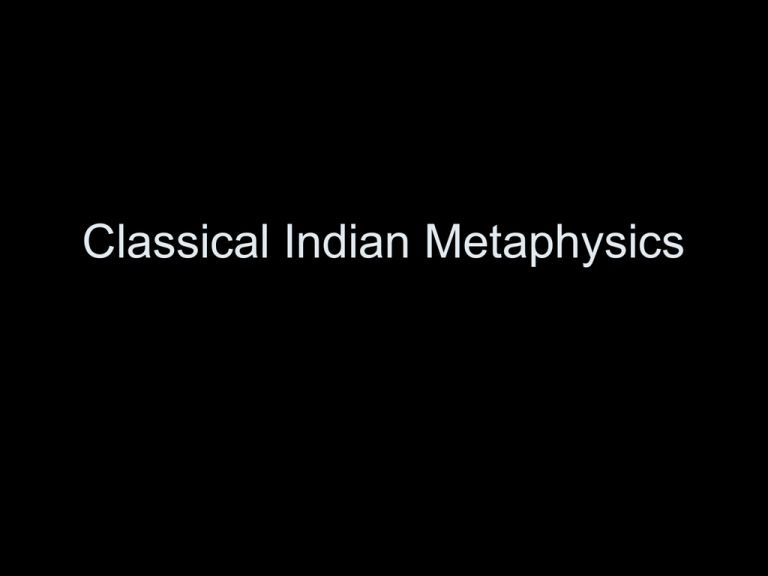
Classical Indian Metaphysics Idealism • Classical Indian metaphysics centers on the contrast between realism and idealism • Buddhism and the most popular school of Hinduism, Advaita Vedanta, are thoroughly idealist • They insist that everything is minddependent Idealism • What appear to be independent objects are mental constructions • Objects do not really endure over time; they exist for no more than a moment • What we take to be objects are really bundles of momentary entities that we group together for our own purposes Realism • Hindu philosophers of the Logic and Particularist schools, in contrast, are realists • They hold that objects such as rocks, stones, and trees are truly “out there” in the world • These objects in no sense depend on our minds • They endure over time Vaisesika (Particularism) • Kanada (c. 100): “I will enumerate everything that has the character of being.” • Fundamental question of ontology: What is there? • Everyday speech and behavior is the touchstone • Categories (padartha, types of things to which words refer) Basic Categories • Substance: pot, cloth, fire, soul • Quality: square, blue • Motion (action): move, eat, throw • These correspond to items in Aristotle's categories, and to • Nouns, adjectives, and verbs • They are existent (sat) Additional Categories • • • • • Universality: triangularity Inherence: the pot's being blue Individualizer: differentiates atoms (‘this’) Absence: the elephant in here The first three are present (bhava); the last, absent (abhava) • But they can all be talked about and named Inherence • Quality • Inherence • Substance Individualizer • • • • Black’s two iron spheres They are qualitatively identical But they are different What distinguishes them? Absences Kanada’s Beard? • How do we know anything about – Universals – Inherence – Particularizers – Absences? Another Trilemma? • We must either – Reinterpret sentences that lead us to introduce these entities (the semantic strategy) – Reinterpret the entities as concepts (the metaphysical strategy) – Postulate some way of knowing these entities (the epistemological strategy) Substance • All the other categories depend on substance • Qualities, quantities, relations, etc., are always of substances • There are many senses in which a thing may be said to be • But all depend on a focal meaning of ‘being’, substance Vaisesika: Kinds of Noncomposite Substance • • • • • Earth Air Fire Water Ether • • • • Space Time Self Mind • Composite substances are the causal result of combinations of these Two Concepts of Substances • • • • • Realist (Aristotle/Vaisesika) The world is divided into Substances— bearers of Qualities We carve the world at joints Idealist (Buddhist) We divide the world into Objects— bundles of Qualities There are no joints Hinduism • Hinduism is the primary religion of India. • It regards the Upanishads (900-200 BCE) as sacred. Henotheism • There are many gods, • But all are forms of one being, Brahman. Rg Veda • “They have styled Him Indra (the Chief of the Gods), Mitra (the Friend), Varuna (the Venerable), Agni (Fire), also the celestial, great-winged Garutma; for although one, poets speak of Him diversely; they say Agni, Yama (Death), and Matarisvan (Lord of breath).” • All these gods exist, but as diverse appearances of one God, “the divine architect, the impeller of all, the multiform.” Bhagavad Gita • “Even those who are devotees of other gods, And worship them permeated with faith, It is only me, son of Kunti, that even they Worship, (tho’) not in the enjoined fashion. For I of all acts of worship Am both the recipient and the Lord. . . .” • “I see the gods in Thy body, O God. . . .” Concepts of Brahman • Nirguna brahman: God without attributes; neti . . . neti (not this) • Saguna brahman: God with attributes Attributes of God • Abstract: – Sat: being – Chit: awareness – Ananda: bliss • Concrete – Creator (Brahma) – Preserver (Vishnu) – Destroyer (Shiva) Six Orthodox Schools (darshanas) • Vedanta (end of Veda, or sacred knowledge) • Samkhya (nature) • Yoga (discipline) • Purva Mimamsa (exegesis, interpretation) • Vaisesika (realism) • Nyaya (logic) Vedanta • Brahman: the Absolute, ground of all being, reality as it is in itself • Atman: the soul Advaita • • • • Nondualism: soul (atman) = Brahman Monism: Everything is ultimately one Everything is Brahman Brahman is the child and the elephant, you and me • We are one with everything • Everything is holy Advaita • Idealism: The world as it appears is not real • Distinctions are illusory • The world is maya (play, illusion) Theism • Dualism: soul (atman) ≠ Brahman • Not everything is identical with everything else • Realism: Some aspects of the world are independent of us • At least some distinctions are real Buddhaghosa (-400) • • • • There are 89 kinds of consciousness Nothing unifies them There are only streams of consciousness Nothing unites past, present, and future Buddhaghosa • A living being lasts only as long as one thought • People, minds, objects are only ways of speaking People and Passengers • Jane flies from Austin to Houston and back <———————————> • She is one person • She is two passengers • ‘Passenger’ is just a way of counting • Buddhaghosa: every noun is like ‘passenger’ Questions to King Milinda • • • • “there is no ego here to be found” “there is no chariot here to be found” No one element is the whole The combination isn’t the whole; parts could change while object remains the same Consciousness-Only • Vasubandhu’s idealism —> Dharmapala —> Xuanzong (596-664) • Idealism: Everything depends on mind • No-self: There is no mind The Atomic Theory of Matter • The atomic theory poses a challenge to this conception of substances • Atomic theory: things are composed of atoms; properties of things depend on nature and motion of atoms Dignaga (c. 450), Buddhist • “Though atoms serve as causes of the consciousness of the sense-organs, they are not its actual objects like the sense organs; because the consciousness does not represent the image of the atoms. The consciousness does not arise from what is represented in it. Because they do not exist in substance just like the double moon. Thus both the external things are unfit to be the real objects of consciousness.” Plato’s Philosophy of Mind The Good • Participation This is a triangle Form Recollection Perception Object Nyaya-Vaisesika Philosophy of Mind • Instantiation Quality This is a triangle Universal Inherence Perception Object Making Universals Mind-Dependent • Application Quality This is a triangle Concept Inherence Perception Object Buddhist Philosophy of Mind • Application This is a triangle Concept Dharma Perception Internal Object Actual Object Nyaya-Vaisesika Conception • There are continuing substances • Qualities inhere in substances • Our talk of substances is a good guide to metaphysics • Substances are the basic constituents of the world • They have essences— properties necessary to them • Their essences give them identity through change The Buddhist Conception • There are no continuing substances • Everything is momentary • “Substances” are just bundles of qualities (dharmas) • Our talk of substances is a convenient fiction • “Substances” are conceptual constructions • Nothing gives them unity • They have essences only as constructed Yogi Berra • “Here’s your pizza, Mr. Berra. Would you like me to cut it into four pieces or eight?” • Yogi: “Better make it four. I don’t think I can eat eight.” Actual and Internal Objects • Aristotle: objects cause perceptions, and are represented in them • Causes of perception = objects of perception • Dignaga: No— – causes are the atoms— actual objects [alambana] – objects are appearances— internal objects [artha] Causes and Effects • Causes of perception are the atoms • We don’t see atoms, but their effects • What we see doesn’t exist in reality; it is “like the double moon” • How could we distinguish aspects of the effects (appearances) that do match the causes? Buddhist Arguments Yogacara (Buddhist idealism): Vasubandhu, Asanga, Samghabhadra (4th century) Argument from Change • Distinctness of discernibles: The same thing can’t have contrary properties • Any difference in properties implies numerical difference • Change implies a difference in properties • So, change implies numerical distinctness • Change occurs at every moment • So, things persist only for a moment Nyaya-Vaisesika Response • • • • Substances can endure through change Substances can have contrary properties Change does not occur at every moment These relations are different: – Substance/properties – Whole/parts – Properties/parts • Things have essences • Qualities • Substance • Atoms Argument from Destruction • Everything is destroyed by its own nature, with no external cause • Everything destroyed by its own nature is destroyed immediately • So, everything is destroyed immediately • So, nothing persists for more than a moment Against External Destruction 1 • A cause can’t have contradictory effects • External causes of destruction would also be causes of production (e.g., fire causing ash) • Destruction and production are contradictory • So, there are no external causes of destruction Against External Destruction 2 • Nonexistence can’t have a cause • Destruction is nonexistence • So, destruction can’t have a cause • Nyaya-Vaisesika response: absences can be causes and effects Immediate Destruction • Say an object is destroyed, not at t, but at a later t’ • Some contributing factor must have absent at t but present at t’ • But no external factor can contribute to the thing’s destruction • So, the factor must be part of the thing’s nature • But the thing has the same nature at t and t’; contradiction Argument from Causality • Everything that exists is causally efficient • Everything causally efficient is momentary • So, everything that exists is momentary Capacities • There are no unrealized capacities • So, anything that can cause something causes it immediately • So, things have different capacities at different times • Difference in capacities implies numerical distinctness • So, nothing persists for more than a moment Argument from Momentariness • Mental states are momentary • Anything that depends on something momentary is momentary • The body depends on mental states • So, the body is momentary Argument from Momentariness • Mental states are momentary • Anything that causes something momentary is momentary • Physical objects cause mental states • So, physical objects are momentary Argument from consciousness • Dignaga: We know world only through sense organs • So, we know objects only insofar as they become internal objects • They are objects of consciousness, constituted by consciousness • We know objects only as conditioned by consciousness Jainist Perspectivism • Jainism, a religion and philosophy tracing from Mahavira (599-527 BCE), is best known for its emphasis on nonviolence • Jainism also advances a version of perspectivism Jain Ethics • Jains base their ethical views on five great vows: – 1. noninjury – 2. truthfulness – 3. respect for property – 4. chastity – 5. nonattachment Jain Metaphysics • They believe that these vows can be fulfilled only from a certain metaphysical standpoint • A conviction that one has the absolute truth, for example, is likely to lead one to be willing – to injure others for its sake, and – to become attached to it Nonabsolutism • Nonabsolutism (anekantavada, nonone-sidedness): no statement captures the truth absolutely • Everything we say is true, at best, in some respect • Nothing is true simpliciter Nonabsolutism • The same is true of falsehood • Every statement approaches its topic from one point of view • To understand any topic, however, we must see it from many points of view Respect • We should respect people no matter what they believe or say, therefore, because every statement contains some element of truth • Everything is true in some respect, or from some point of view Multifaceted Reality • Reality is many-sided • Indeed, it has infinitely many facets, some of which are opposites • Whatever we say is true syat, maybe, perhaps, in some respect • It is also false in some respect • We never capture the whole truth Language • Accompanying nonabsolutism is a view of language • Maybeism, or relativism (syadvada): language can express the truth only from some point of view Law of Sevenfold Predication • Vadi Devasuri (twelfth century) develops this into a theory of language based on the Law of Sevenfold Predication: – 1. It is – 2. It is not – 3. It is and is not – 4. It is indeterminate – 5. It is and is indeterminate – 6. It is not and is indeterminate – 7. It is and is not and is indeterminate Pluralism • Nonabsolutism implies a positive pluralism of perspectives • Reality is so rich that it makes true, with qualifications, every intellectual stance • Reality is so incredibly rich that it can underlie and give rise to opposed pictures Skepticism • Nonabsolutism ≠ skepticism • It promises reconciliation of apparently opposed points of view • It targets only the absolutism that partisans propose for their preferred positions, blind to the truth in their opponents’ theories Intellectual Nonviolence • The point is not to deny but to affirm seemingly incompatible perspectives • The special sevenfold logic, the maybeism, was developed to facilitate the disarming of controversy • Here are the tools of intellectual nonviolence (ahimsa) Self-Defeating? • Is the Jain position self-defeating? • Jainists say no. It is not meant to be an absolute claim • That would be like practicing ahimsa toward everyone except oneself • Nonharmfulness requires humility • So, the Jainist offers it merely as one perspective alongside others


